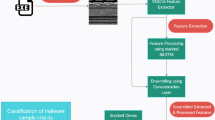Abstract
Malware is dangerous for system and network users. Malware identification is an essential task in effectively detecting and preventing the computer system from self-infection, protecting it from potential data loss and system compromise. Commonly, there are 25 malware families exist. Traditional malware detection and anti-virus systems fail to classify the new variants of unknown malware into their corresponding families with the development of malicious code engineering, and it is possible to understand the malware variants and their features for new malware samples that carry variability and polymorphism. The detection methods can rarely detect such variants, but it is important in the cybersecurity field to investigate and detect large-scale malware samples more efficiently. In this paper, an accurate malware family classification model using a convolutional neural network technique is proposed. Malware family recognition is formulated as a multi-classification task, and an accurate solution is obtained by training convolutional neural network with images of malware executable files. Ten families of malware have been considered here for building the models. The image dataset with 2000 instances is applied to a convolutional neural network to build the classifier. The experimental results, based on a dataset of ten classes of malware families and 2000 malware images trained model, provide an accuracy of over 95% in discriminating from malware families. The techniques provide better results for classifying malware into families.
Access this chapter
Tax calculation will be finalised at checkout
Purchases are for personal use only
Similar content being viewed by others
References
B. Kolosnjaji, A. Zarras, G. Webster, C. Eckert, Deep learning for classification of malware system call sequences, in Australasian Joint Conference on Artificial Intelligence. Springer, 2016, 137–149
L. Nataraj, S. Karthikeyan, G. Jacob, B. Manjunath, Malware images: visualization and automatic classification, Proceedings of the 8th International Symposium on Visualization for Cyber Security, Article No. 4, 2011
N.S. Netanyahu, O.E. David Deepsign, Deep learning for automatic malware signature generation and classification in Neural Networks (IJCNN), 2015 International Joint Conference on. IEEE, 2015, pp. 1–8
R. Tian, L. Batten, R. Islam, S. Versteeg, An automated classification system based on the strings of trojan and virus families, Proceedings of the 4th International Conference on Malicious and Unwanted Software, (Montréal, 13 October 2009)
K. Kim et al., Network intrusion detection using deep learning, Springer Cyber Security Systems and Networks Springer Nature Singapore Pte Ltd
B. Cakir, E.. Dogdu, Malware classification using deep learning methods on ACM SE ’18: ACM SE ’18: Southeast Conference, Richmond, KY, USA. ACM, New York, NY, USA, p. 5
M. Bailey, J. Oberheide, J. Andersen, Z.M. Mao, F. Jahanian, J. Nazario, Automated classification and analysis of internet malware, in Proceedings of the 10th Symposium on Recent Advances in Intrusion Detection
R. Islam, R. Tian, L. Battenb, S. Versteeg, Classification of malware based on integrated static and dynamic features. J. Netw. Comput. Appl. 36, 646–556 (2013)
N. Bhodia, P. Prajapati, F.D. Troia, M. Stamp, Transfer learning for image-based malware classification in ICISSP 2019, Czech Republic, 2019
M. Kalash, M. Rochan, N. Mohammed, N. D.B. Bruce, Y. Wang, Malware classification with deep convolutional neural networks, 2018 9th IFIP NTMS, 2018
Author information
Authors and Affiliations
Editor information
Editors and Affiliations
Rights and permissions
Copyright information
© 2021 The Author(s), under exclusive license to Springer Nature Singapore Pte Ltd.
About this paper
Cite this paper
Gayathri, T., Vijaya, M.S. (2021). Malware Family Classification Model Using Convolutional Neural Network. In: Bhateja, V., Satapathy, S.C., Travieso-González, C.M., Aradhya, V.N.M. (eds) Data Engineering and Intelligent Computing. Advances in Intelligent Systems and Computing, vol 1407. Springer, Singapore. https://doi.org/10.1007/978-981-16-0171-2_3
Download citation
DOI: https://doi.org/10.1007/978-981-16-0171-2_3
Published:
Publisher Name: Springer, Singapore
Print ISBN: 978-981-16-0170-5
Online ISBN: 978-981-16-0171-2
eBook Packages: Intelligent Technologies and RoboticsIntelligent Technologies and Robotics (R0)




